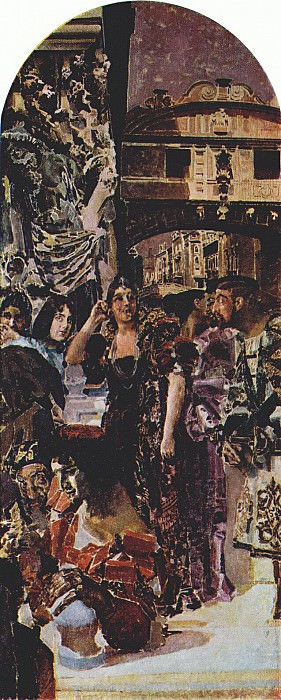vrubel venice decorative panel 1893 Mikhail Vrubel (1856-1910)
Mikhail Vrubel – vrubel venice decorative panel 1893
Edit attribution
Download full size: 637×1592 px (0,2 Mb)
Painter: Mikhail Vrubel
Mikhail Vrubel was a well-known Russian artist who paid much attention not only to painting the beauties of his homeland, but also tried to convey to the Russian viewer the beauty of the foreign country he saw. Between 1891 and 1894 the artist travels through Europe, visiting Venice, Paris, Milan, Rome, Athens, visits Spain. The main purpose of the trip is to see the world and get inspiration for the creation of new subjects, which he managed to see in large numbers, the ideas just poured out, the artist had only to translate them into reality.
Description of Mikhail Vrubel’s painting "Venice"
Mikhail Vrubel was a well-known Russian artist who paid much attention not only to painting the beauties of his homeland, but also tried to convey to the Russian viewer the beauty of the foreign country he saw.
Between 1891 and 1894 the artist travels through Europe, visiting Venice, Paris, Milan, Rome, Athens, visits Spain. The main purpose of the trip is to see the world and get inspiration for the creation of new subjects, which he managed to see in large numbers, the ideas just poured out, the artist had only to translate them into reality. So, after visiting Venice and returning to Russia, Vrubel writes a decorative panel with the same name and gives it to the house Dunker in the capital.
The canvas, painted in the spirit of the Renaissance, depicts Venice in all its glory, in the midst of the great Venice Festival, one of the oldest festivals in the world. At the center of the painting are two women dressed up for the festivities, behind them a street full of a buzzing crowd and ancient buildings, among which the edge of the Palazzo Dodges and the Bridge of Sighs are clearly visible. A patrician occupies the side of the panel as he gazes at his neighbor across the street, an apparently quiet conversation taking place, secrets being born and revealed.
In painting the canvas the artist used photographs, considering that there is nothing unnatural in it, as photos of places where you can never visit, or photos of places, memories of which are weak for the artist can be an indispensable aid in his work.
The picture, in general, is somber and it is impossible to understand how the events depicted in it are credible, because carnival, as the Italians themselves believe, is not subject to such a concept as time, which means it is quite possible that the artist will meet his characters personally on one of his trips through the city drowning in a festive carnival procession.
Кому понравилось
Пожалуйста, подождите
На эту операцию может потребоваться несколько секунд.
Информация появится в новом окне,
если открытие новых окон не запрещено в настройках вашего браузера.
You need to login
Для работы с коллекциями – пожалуйста, войдите в аккаунт (open in new window).


















You cannot comment Why?
Perhaps it’s a painting of a group of people standing in front of a bookshelf with a woman holding an umbrella.